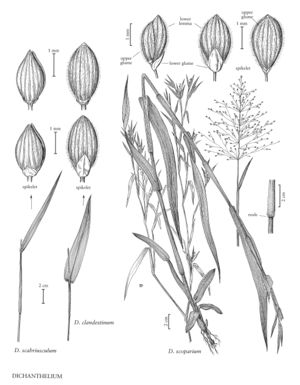Difference between revisions of "Dichanthelium clandestinum"
FNA>Volume Importer |
imported>Volume Importer |
||
| (5 intermediate revisions by 2 users not shown) | |||
| Line 4: | Line 4: | ||
|publications= | |publications= | ||
|common_names=Deer-tongue grass;Panic clandestin | |common_names=Deer-tongue grass;Panic clandestin | ||
| + | |special_status={{Treatment/ID/Special_status | ||
| + | |code=E | ||
| + | |label=Endemic | ||
| + | }} | ||
|basionyms= | |basionyms= | ||
|synonyms={{Treatment/ID/Synonym | |synonyms={{Treatment/ID/Synonym | ||
|name=Panicum latifolium var. clandestinum | |name=Panicum latifolium var. clandestinum | ||
| − | |authority= | + | |authority= |
| + | |rank=variety | ||
}} {{Treatment/ID/Synonym | }} {{Treatment/ID/Synonym | ||
|name=Panicum clandestinum | |name=Panicum clandestinum | ||
| − | |authority= | + | |authority= |
| + | |rank=species | ||
}} | }} | ||
|hierarchy=Poaceae;Poaceae subfam. Panicoideae;Poaceae tribe Paniceae;Dichanthelium;Dichanthelium sect. Clandestina;Dichanthelium clandestinum | |hierarchy=Poaceae;Poaceae subfam. Panicoideae;Poaceae tribe Paniceae;Dichanthelium;Dichanthelium sect. Clandestina;Dichanthelium clandestinum | ||
| Line 22: | Line 28: | ||
-->{{Treatment/Body | -->{{Treatment/Body | ||
| − | |distribution=Conn.;N.J.;N.Y.;Del.;D.C;W.Va.;Fla.;N.H.;Tex.;La.;N.S.;Ont.;Que.;Tenn.;N.C.;S.C.;Pa.;Va.;Mass.;Maine;R.I.;Vt.;Ala.;Ark.;Ill.;Ga.;Ind.;Iowa;Md.;Kans.;Okla.;Ohio;Mo.;Mich.;Miss.;Ky. | + | |distribution=Conn.;N.J.;N.Y.;Del.;D.C.;W.Va.;Fla.;N.H.;Tex.;La.;N.S.;Ont.;Que.;Tenn.;N.C.;S.C.;Pa.;Va.;Mass.;Maine;R.I.;Vt.;Ala.;Ark.;Ill.;Ga.;Ind.;Iowa;Md.;Kans.;Okla.;Ohio;Mo.;Mich.;Miss.;Ky. |
|discussion=<p><i>Dichanthelium clandestinum</i> usually grows in semi-open areas in damp or sandy woodlands, thickets, or on banks. It is restricted to the eastern part of the Flora region. The primary panicles are open-pollinated for a brief period, and produced from late May to early July; the secondary panicles, which are cleistogamous and usually concealed within the sheaths, are produced from July through September.</p><!-- | |discussion=<p><i>Dichanthelium clandestinum</i> usually grows in semi-open areas in damp or sandy woodlands, thickets, or on banks. It is restricted to the eastern part of the Flora region. The primary panicles are open-pollinated for a brief period, and produced from late May to early July; the secondary panicles, which are cleistogamous and usually concealed within the sheaths, are produced from July through September.</p><!-- | ||
--><p><i>Panicum</i> recognitum Fernald refers to rare sterile hybrids with <i>Dichanthelium dichotomum</i> and perhaps <i>D. scoparium</i>; P. aculeatum Hitchc. & Chase to putative sterile hybrids with <i>D. scabriusculum</i> or <i>D. dichotomum</i>.</p> | --><p><i>Panicum</i> recognitum Fernald refers to rare sterile hybrids with <i>Dichanthelium dichotomum</i> and perhaps <i>D. scoparium</i>; P. aculeatum Hitchc. & Chase to putative sterile hybrids with <i>D. scabriusculum</i> or <i>D. dichotomum</i>.</p> | ||
| Line 33: | Line 39: | ||
-->{{#Taxon: | -->{{#Taxon: | ||
name=Dichanthelium clandestinum | name=Dichanthelium clandestinum | ||
| − | |||
|authority=(L.) Gould | |authority=(L.) Gould | ||
|rank=species | |rank=species | ||
| Line 40: | Line 45: | ||
|basionyms= | |basionyms= | ||
|family=Poaceae | |family=Poaceae | ||
| − | |distribution=Conn.;N.J.;N.Y.;Del.;D.C;W.Va.;Fla.;N.H.;Tex.;La.;N.S.;Ont.;Que.;Tenn.;N.C.;S.C.;Pa.;Va.;Mass.;Maine;R.I.;Vt.;Ala.;Ark.;Ill.;Ga.;Ind.;Iowa;Md.;Kans.;Okla.;Ohio;Mo.;Mich.;Miss.;Ky. | + | |illustrator=Linda A. Vorobik;Hana Pazdírková |
| + | |illustration copyright=Utah State University | ||
| + | |distribution=Conn.;N.J.;N.Y.;Del.;D.C.;W.Va.;Fla.;N.H.;Tex.;La.;N.S.;Ont.;Que.;Tenn.;N.C.;S.C.;Pa.;Va.;Mass.;Maine;R.I.;Vt.;Ala.;Ark.;Ill.;Ga.;Ind.;Iowa;Md.;Kans.;Okla.;Ohio;Mo.;Mich.;Miss.;Ky. | ||
|reference=None | |reference=None | ||
|publication title= | |publication title= | ||
|publication year= | |publication year= | ||
| − | |special status= | + | |special status=Endemic |
| − | |source xml=https:// | + | |source xml=https://bitbucket.org/aafc-mbb/fna-data-curation/src/200273ad09963decb8fc72550212de541d86569d/coarse_grained_fna_xml/V25/V25_1147.xml |
|subfamily=Poaceae subfam. Panicoideae | |subfamily=Poaceae subfam. Panicoideae | ||
|tribe=Poaceae tribe Paniceae | |tribe=Poaceae tribe Paniceae | ||
Latest revision as of 17:55, 11 May 2021
Plants forming large clumps, with rhizomes 3-5 mm thick. Basal rosettes well-differentiated; sheaths pubescent; blades ovate to lanceolate. Culms 50-140 cm, stout, pilose with papillose-based hairs to subglabrous; fall phase branching from the mid- and upper culm nodes, with a few, nearly erect, elongate branches, sparsely rebranching, sheaths overlapping, concealing the secondary panicles; nodes not swollen, glabrous or sparsely pubescent. Cauline leaves 5-10; sheaths not overlapping, striate-ribbed, narrowing above midlength, hispid to sparsely hirsute, hairs sometimes papillose-based, summits mottled with pale spots, margins ciliate, collars puberulent; ligules 0.4-0.9 mm, membranous; blades 10-25 cm long, 15-30 mm wide, flat, lanceolate, often rigid, glabrous or sparsely pubescent, with 9-13 major veins and 40-80 minor veins, bases cordate, with papillose-based cilia, apices acuminate. Primary panicles 8-16 cm long, 4-12 mm wide, exserted, with many spikelets. Spikelets 2.4-3.6 mm long, 1.2-1.5 mm wide, narrowly ellipsoid, sparsely pubescent. Lower glumes 1/3 – 1/2 as long as the spikelets, narrowly triangular; upper glumes and lower florets slightly shorter than the spikelets, with 7 or 9 prominent veins; lower florets sterile; upper florets umbonate, apices with a minute tuft of hairs. 2n = 36.
Distribution
Conn., N.J., N.Y., Del., D.C., W.Va., Fla., N.H., Tex., La., N.S., Ont., Que., Tenn., N.C., S.C., Pa., Va., Mass., Maine, R.I., Vt., Ala., Ark., Ill., Ga., Ind., Iowa, Md., Kans., Okla., Ohio, Mo., Mich., Miss., Ky.
Discussion
Dichanthelium clandestinum usually grows in semi-open areas in damp or sandy woodlands, thickets, or on banks. It is restricted to the eastern part of the Flora region. The primary panicles are open-pollinated for a brief period, and produced from late May to early July; the secondary panicles, which are cleistogamous and usually concealed within the sheaths, are produced from July through September.
Panicum recognitum Fernald refers to rare sterile hybrids with Dichanthelium dichotomum and perhaps D. scoparium; P. aculeatum Hitchc. & Chase to putative sterile hybrids with D. scabriusculum or D. dichotomum.
Selected References
None.
